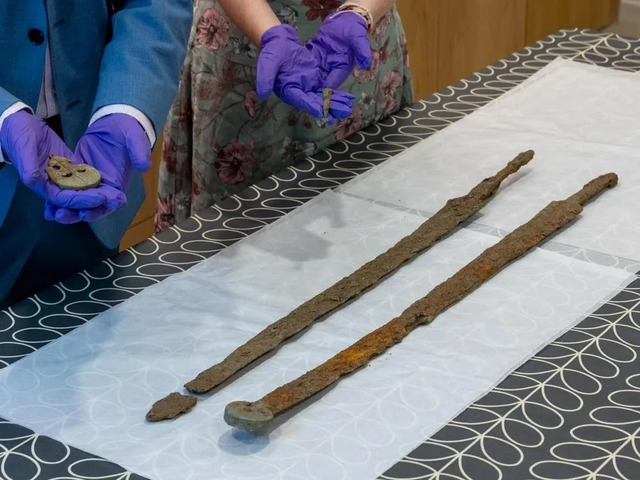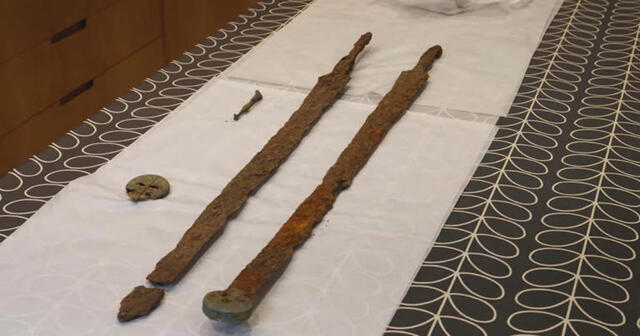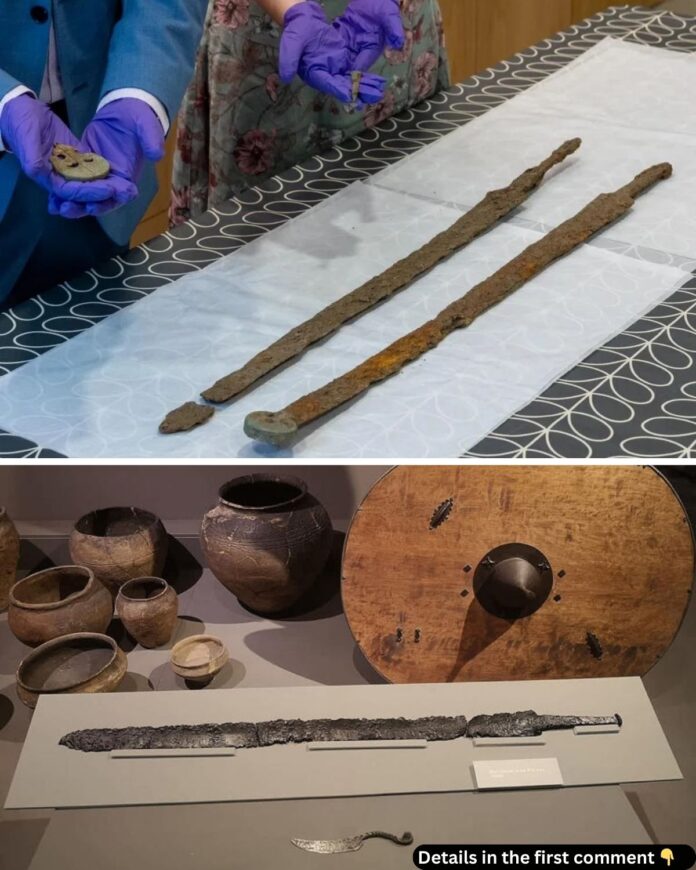The discovery of two Roman cavalry swords in the North Cotswolds, England, has captured the imagination of archaeologists and historians alike. Unearthed by metal detectorist Glenn Manning during a rally, these 1,800-year-old swords still encased in their wooden sheaths represent a rare glimpse into the martial practices of Roman Britain. This finding not only underscores the region’s deep historical significance but also offers valuable insights into the weaponry and culture of the Roman cavalry.
Discovery of the Roman Cavalry Swords
The swords were uncovered during a metal detecting rally, where Glenn Manning stumbled upon these extraordinary artifacts buried together in the soil. Likely of the spatha variety, these swords were characterized by their long, straight blades, ideal for use on horseback. The remnants of wooden sheaths encasing the blades were still intact, adding a unique layer of preservation to this significant find.
Simon James, an archaeologist at the University of Leicester, emphasized the rarity of such discoveries. “In terms of parallels, I can’t think of finds of more than one sword being deposited in any similar circumstance from Roman Britain,” he remarked. This exceptional discovery is now being analyzed to unravel the story of their owners and the circumstances under which these weapons were buried.

Video
Discover 2nd-century Roman cavalry swords uncovered in the Cotswolds – watch the video to explore this incredible archaeological find and its connection to ancient Rome!
The Roman Spatha: A Cavalry Weapon
The spatha, a weapon of choice for Roman cavalry officers, gained prominence in the Roman Empire around 160 CE. Designed with a longer blade than the standard Roman gladius, the spatha was particularly effective for mounted combat. Its design allowed cavalry soldiers to strike with precision while on horseback, offering an advantage over shorter weapons in battle.
Similar examples of spatha swords have been found elsewhere, including a notable discovery in Canterbury, where two swords were uncovered in a pit within the city walls. Archaeologists speculated that their burial might be linked to a double murder, highlighting the varied contexts in which these swords were used and deposited.
Archaeological Analysis and Preservation

The two cavalry swords are currently undergoing detailed analysis, including X-ray imaging, to uncover hidden details and better understand their construction and use. The swords have been entrusted to the Corinium Museum, where they will be carefully preserved before being displayed for public viewing in the coming years.
The preservation of such artifacts is crucial not only for their historical value but also for the education and engagement of future generations. These swords serve as a tangible connection to the Roman Empire’s presence in Britain, offering a glimpse into the lives of cavalry soldiers who once patrolled these lands.
Historical Context of the Discovery Site
The Cotswolds, known for its rolling hills and picturesque landscapes, also holds a rich Roman history. During the Roman Empire, the region was home to Cirencester, or Corinium Dobunnorum, which became the second-largest Roman town in Britain after Londinium (London). As a thriving center of trade and administration, Cirencester played a pivotal role in Roman Britain’s economy and governance.
The discovery of the swords further highlights the historical depth of the Cotswolds, emphasizing its importance as a crossroads of Roman military and civilian life. As Cllr Paul Hodgkinson from the Cotswold District Council aptly noted, “This new discovery shows what an incredibly deep history the Cotswolds has.”
Comparisons to Similar Discoveries in Europe
The Cotswolds swords are not the only significant spatha find in recent years. Earlier this summer, archaeologists in Germany uncovered a 1,300-year-old spatha sword buried alongside a Frankish warrior. Such discoveries highlight the widespread use of spatha swords across Europe, illustrating their importance in both Roman and post-Roman military traditions.
While the German find reflects the enduring legacy of the spatha beyond the Roman Empire, the Cotswolds swords offer a snapshot of Roman Britain during its peak. Together, these finds enrich our understanding of the role of cavalry in ancient military strategies and the technological advancements of the time.
Future Excavations and Research

The discovery site in the North Cotswolds holds immense potential for further archaeological exploration. Researchers are considering revisiting the site to conduct more extensive excavations, which could uncover additional artifacts or provide context for the burial of the swords.
These efforts are part of a broader mission to piece together the history of Roman Britain, shedding light on its military, economic, and cultural landscape. Each artifact unearthed contributes to a more comprehensive narrative of life in Roman Britain, highlighting the complexities and innovations of this ancient civilization.
Conclusion
The discovery of two Roman cavalry swords in the Cotswolds serves as a poignant reminder of the region’s rich historical tapestry. These spatha swords, preserved with their wooden sheaths, offer an unparalleled glimpse into the martial practices of Roman Britain and the lives of the cavalry officers who wielded them.
As the swords undergo analysis and preservation, they hold the promise of unlocking new insights into the Roman Empire’s presence in Britain. Their eventual display at the Corinium Museum will allow the public to engage with this remarkable chapter of history, fostering a deeper appreciation for the legacy of ancient civilizations.
Through continued research and excavation, the story of these swords—and the world they belonged to—will undoubtedly unfold, providing valuable lessons and inspiration for generations to come.
